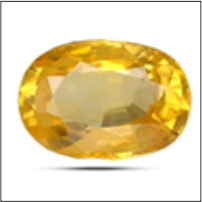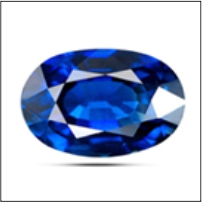

ORIGIN:
Sapphires are a pure form of the mineral corundum. For thousands of years, sapphire has been associated solely with the colour blue. The ancient Persians believed that the earth rested on a giant sapphire that gave its blue reflection to the sky, hence the Latin word "saphirus" and the Greek word "sapheiros," which means blue. The word “sapphire” is also derived from Sanskrit word ‘Shanipriya’ literally meaning “dear to Saturn”. Sapphire is considered one of the “big three” in the industry with ruby and emeralds. Sapphire is the gem of truth. The sapphire was honoured by ancient priests and sorcerers for it was said to enable them to foretell the future. Ancients believed the Ten Commandments were written on a sapphire tablet.
Since the word sapphire is synonymous with the colour blue, many people don't realize that sapphire comes in other colour shades like pink, yellow, purple, orange and white. However, sapphires can be found in every colour besides red, as red sapphires are called rubies. Yellow sapphire deserves more recognition. Its sunny colour is an instant mood-enhancer on the greyest day. Rare and beautiful, yellow sapphire complements yellow gold and takes center stage set when contrasting against white gold and diamonds. Pink sapphire is even rarer than blue: in some ways, it has more in common with ruby than the other colours of sapphire. Gem experts often debate where ruby ends and pink sapphire begins, since pink is really just light red.
Sapphires most commonly occur in blue, and vivid, pure, deep blues are the most valuable. The expensive Sapphires are known to be of powerful and are of pure bright blue colour. High quality sapphires are very rare in gem mines across the world. The brightness of this gemstone is maintained in all kinds of lighting conditions. This gemstone is available in size of up to 2 carats. You may also get 5-10 carats of gems. It is usually cut in a rounded rectangle or in oval shape. Sapphires are cut into dome shape and depict the six-rayed white star, which are commonly called as star Sapphires. Small stones are made available in round brilliant cuts and are also available in various other shapes like triangle, emerald, square, pear, cabochon and a lot more. The stone has a very good hardness of 9 on the Mohs scale. In ancient times, a gift of a sapphire was a pledge of trust and loyalty. This tradition makes sapphire a popular choice for engagement rings. Sri Lanka is the biggest producer of sapphires, but they are also mined in Kenya, Burma, Tanzania, Kashmir-India, Madagascar, Thailand, Vietnam, Australia, Cambodia, Laos, Australia, Nigeria, Tanzania, China and the United States.
POWER:
Sapphires were believed to have special protective powers, such as preventing envy and protecting the wearer from poisoning.
In addition, people believed that sapphire had medical healing properties, such as the ability to cure colic, rheumatism, blindness, and mental illnesses.
Sapphire symbolizes fidelity and the soul.
Throughout the course of history, this gem has been worn as a protective amulet, as a symbol of harmony, loyalty and friendship, and as a romantic token.
Yellow Sapphire (Pukhraj): Yellow sapphire gemstones are very useful in astrology and Vedic properties. It has many healing powers and is very important in star signs. The wearer gets plenty of wealth, good health, fame, name, honour and professional success, increase intelligence, make one free from unwanted / unpleasant thoughts. Removes depression. Helps recover from throat troubles. Connected with solar plexus. This stone's main area of influence is the glands in the body such as the pituitary gland and other endocrine glands. Therefore, it is believed to improve the secretion of hormones, ensure normal body function and keep disease at bay. By acting on the chemicals in the body, sapphire also improves the emotional wellbeing, Controls liver and fat of the body. It also helps in finding a suitable match for a life partner.
Blue Sapphire/Neelam: A blue Sapphire is one of the most powerful gems of all. Blue Sapphire removes evil effects of Saturn. It is said that blue sapphire has the magical power to elevate its user to a higher status from all sides. It alleviates long-term misfortune. However, there is a caution. Sometimes this stone may react adversely. It is suggested that Blue Sapphire should be tested for one week before final wearing. It could give you everything you could desire such as health, wealth, longevity, happiness. It also restores lost wealth and property. Can improve fertility in a barren woman. It Controls muscles of body. Connected with brow chakra, controls the anger. It has special power of judgment & healing. Blue Sapphire is known to be the best blue gemstone, which is a perfect symbol of remembrance, faith and lasting commitment.